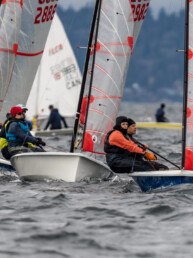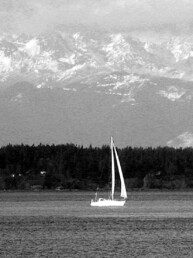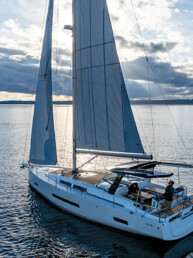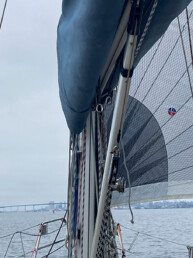“We just have to sail the wind we’ve got.” I couldn’t begin to count the number of times I’ve heard or offered that ubiquitous suggestion on a sailboat.
This message illuminates the limitations (and possibilities) of our eminently condition-dependent activity. With sails up, we are at the behest of the breeze. Sailors seek to enjoy a productive partnership with the wind, in which it is the constant and our actions are the variable. We might want to sail due north, but if that’s where the wind is coming from, it is fundamentally impossible to do so. Tacking can get us there, but is itself a compromise within the boundaries the weather provides. Sometimes there’s no wind and you’re genuinely stuck. Other times, there’s too much wind, and you might have to wait for a different day to try out your pretty new spinnaker.
In a racing context, this phrase usually insinuates that everyone must make the best of whatever conditions they have at any given moment. A racer might see a competitor flying up the course on a big lifting puff along the shore. Sure it looks nice, but if you’re even a few hundred yards away, there is no benefit to adjusting your course to match until you’ve actually reached that shift. Perhaps there’s much more pressure on the other side of the racecourse; you still have to maximize your performance in the lighter conditions until you get to that puff or it gets to you.
A transition zone, where different breezes converge, is one of the most difficult areas in which to succeed at this effort. Many of the observable inputs around you might conflict — a boat nearby could be sailing downwind on port tack with a spinnaker in a southerly while another might be sailing upwind on a starboard tack in a northwesterly. In convergence situations, one of the breezes is usually going to win out. However, arriving any amount early at a sail configuration or heading that will perform best in the conditions that may eventually prevail will likely harm your ability to make good progress through the transition.
We experience this a lot in Puget Sound distance races, and had some great examples in the first two Center Sound Series races in March. In these events, as is frequently the case, there was an advantage to simply keeping the boat moving — in pretty much any direction — through a transition. Boat speed, apparent wind, momentum… when the winds get light, they all have an outsized impact. Crucially, they also give you options to tack, change course, or get to another part of the racing area. Sail the breeze you’ve got pairs perfectly with the notion, ‘when things get tough, just keep moving!’
Like so many things in sailing, there are lessons from the water that can be applied when we are ashore. What I get from this sailing proverb is the idea that wishing doesn’t take us very far, especially in situations where we lack a certain amount of control. Dreams are important, but it doesn’t always serve us well to be too future-focused, especially if we aren’t thinking about how our efforts today “connect the puffs” to get us where we hope to be. It’s a reminder that the breeze you envied on the other side of the course may be gone by the time you get there. And, it invokes the concept that inaction (or a lack of boat speed) can often be more detrimental to our goals than less-than-ideal action.
Sailing is as good as any activity I’ve encountered at grounding me in the moment. There’s always value in strategizing for the future or analyzing the past, but the best thing you can do on a boat is trim your sails and drive the heading the conditions afford right now.
I’ll see you on the water,
Joe
Title background photo courtesy of Sean Trew.
Joe Cline
Joe Cline has been the Managing Editor of 48° North since 2014. From his career to his volunteer leadership in the marine industry, from racing sailboats large and small to his discovery of Pacific Northwest cruising —Joe is as sail-smitten as they come. Joe and his wife, Kaylin, have welcomed a couple of beautiful kiddos in the last few years, and he is enjoying fatherhood while still finding time to make a little music and even occasionally go sailing.






